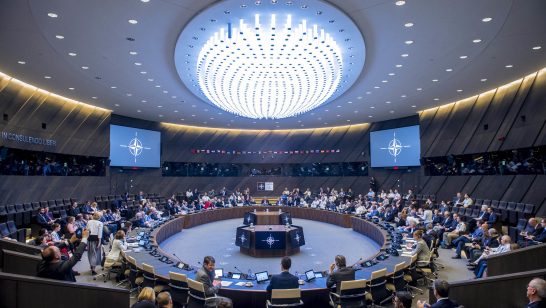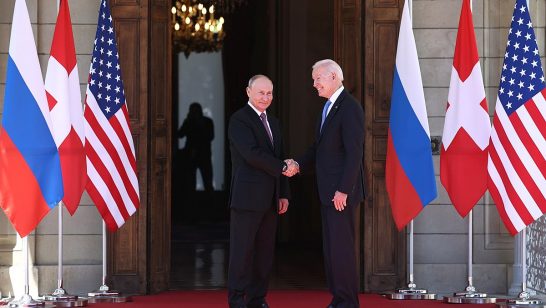
This commentary originally appeared in The Hill.
NATO leaders meet in Madrid in just over two weeks’ time on 29 – 30 June. Among other things, they are pledged to agree a new Strategic Concept, replacing the one that has broadly guided the Alliance since 2010.
The Strategic Concept is not the Alliance’s only guiding document. But it does set tone and direction for many years to come and is referred to almost daily as NATO’s 30 nations struggle to forge consensus. It is important to get it right.
Maybe the confrontation with Russia will make this too difficult or premature and leaders will defer the new Concept until 2023. But all Allies recognise that the 2010 language on Russia is wildly out of date. And so too is the language on deterrence.
The Alliance is facing an unstable period of cold war-style dynamics and potential nuclear brinkmanship. Strong defence will be essential. The next Concept will rightly reflect moves already underway towards increased defence expenditure, greater national resilience, and increased consultation and Alliance cohesion. This will include forward deployment of forces and enhanced operational activity along NATO/Russia borders.
But while strong defence is necessary for deterrence, it does not guarantee it. For effective collective defence in unstable times, the 2022 Strategic Concept must deliver modern deterrence fit for the next decade.
That means changes from the 2010 Concept, which was written for a less demanding era. The new wording should adapt existing text but give sharper focus and clearer intent. The 2022 Concept should move the Alliance beyond 2010’s purely military conception of deterrence to modern, full-spectrum deterrence in peace, crisis and war, using all the tools available to NATO and developing intellectual capital on deterrence across all levels of the Alliance.
Agreed NATO language since 2010 already recognises the need for modern deterrence to be full spectrum. But the 2022 Concept should further guide Allies on how. Four quite simple adjustments would make NATO’s deterrence more effective at lower risk and lower cost.
First, resilience. The first segment of the deterrence spectrum is to deny your enemy the ability to damage or coerce you. Allies are already sharply focused on things like diversifying energy supplies and defending against cyberattack. Last year, they agreed, painfully, on reviewing each other’s resilience, because to an important degree the Alliance is only as strong as its weakest link. But national resilience wasn’t explicitly part of 2010 deterrence. It needs to be made integral in 2022.
Second, communication. Deterrence is all about what goes on in the mind of the adversary. Russia’s invasion of Ukraine shows just how spectacularly Moscow can miscalculate not only its next door neighbour Ukraine but also the West as a whole. The Alliance needs not just the capability and credibility to defend itself but also the ability to communicate those facts accurately to its adversaries. Far more than in 2010, the new Concept must say how NATO will enhance its channels of diplomatic and military communication and use the full potential of its existing ones to plant deterrence, risk reduction and de-escalation with maximum effectiveness into Kremlin and other hostile minds.
Third, shaping deterrence through diplomacy. NATO seeks international stability with undiminished security for all. It has always sought negotiated agreements to deliver this. Arms control is in NATO’s DNA, as is the diplomacy with which to deliver it, because arms control can facilitate better deterrence at lower risk and lower cost. The 2010 Concept doesn’t describe arms control and the diplomacy to deliver it as a part of deterrence. The new Concept should make arms control central to NATO’s modern deterrence toolkit, shaping the confrontation with Russia and putting Moscow on the diplomatic defensive.
Fourth, updating for the coming decade. Emerging disruptive technologies are already accepted in the 2010 Concept as a part of deterrence. But less is said about their impact on strategic decision making (including nuclear): so many new technologies from hypersonic missiles through space weapons to artificial intelligence can distort or disrupt decisions.The complexity of the interaction of disruptive technologiesis an issue in itself. Effective decision making is key to deterrence credibility. So the 2022 Concept should include not just keeping the Alliance on the technological front edge, understanding the threats and exploiting the opportunities, but also confronting the challenges of technological complexity for NATO decision making. Thus ensuring that mitigation is a central part of Alliance capability and institutional development for the years to come.
If the 2022 Concept sets the course, the detailed planning will follow – and NATO will be safer because its deterrence will be stronger.
The opinions articulated above represent the views of the author(s) and do not necessarily reflect the position of the European Leadership Network or any of its members. The ELN’s aim is to encourage debates that will help develop Europe’s capacity to address the pressing foreign, defence, and security policy challenges of our time.
Image: Flickr, Latvijas armija




